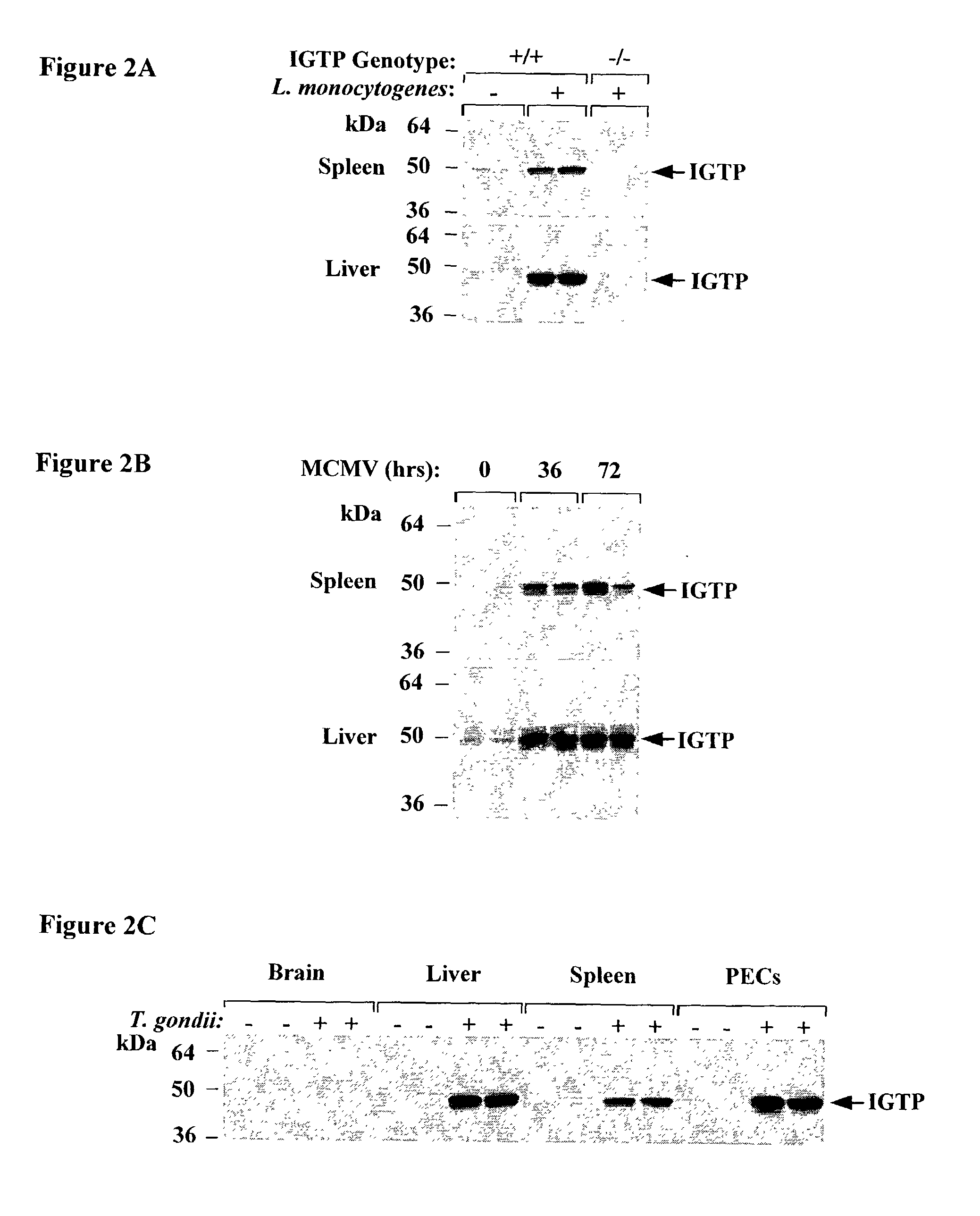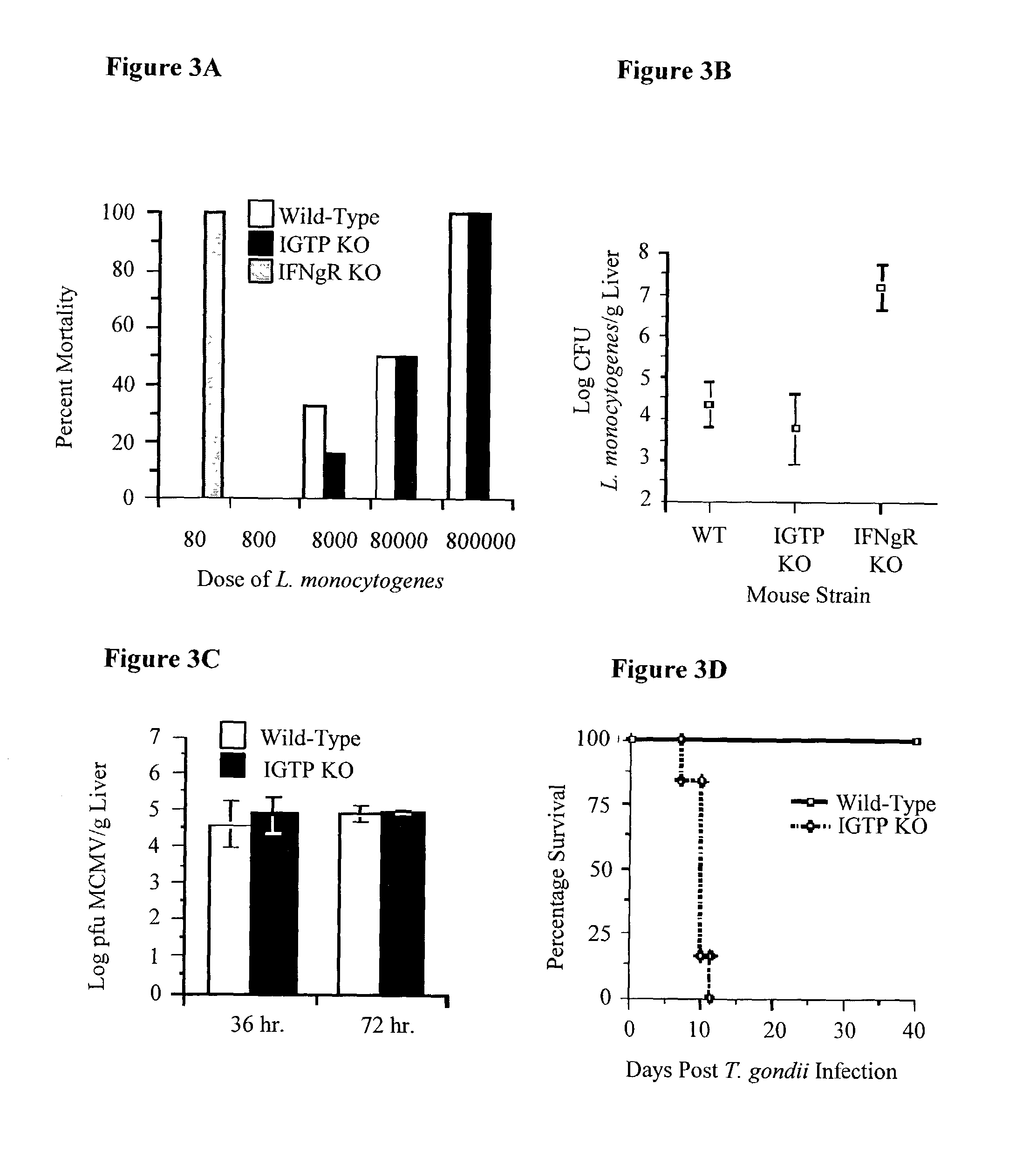Molecules that influence pathogen resistance
- Summary
- Abstract
- Description
- Claims
- Application Information
AI Technical Summary
Benefits of technology
Problems solved by technology
Method used
Image
Examples
example 1
[0167] Nucleotide and Amino Acid Sequence Variants of IGTP-fanily Proteins
[0168] Variant IGTP-family proteins include proteins that differ in amino acid sequence from the prototypical sequences (IGTP: GenBank Accession No. U53219; IRG-47: Accession M63630; LRG-47: Accession U19119) but that share at least 70% amino acid sequence homology with this protein sequence, and that maintain immune-modulating activity. Other variants will share at least 75%, at least 80%, at least 90%, at least 95%, or at least 98% amino acid sequence homology. Manipulation of the nucleotide sequence of IGTP using standard procedures, including for instance site-directed mutagenesis or PCR, can be used to produce such variants. The simplest modifications involve the substitution of one or more amino acids for amino acids having similar biochemical properties. These so-called conservative substitutions are likely to have minimal impact on the activity of the resultant protein. Table 2 shows amino acids that m...
example 2
IGTP Encoding Sequences in Other Animal Species
[0178] Considering the importance of IGTP to the murine response to infection, particularly intracellular infectious agents such as infection by parasites and bacteria, homologs of IGTP-family genes are likely to be present in a number of animal species, especially those susceptible to similar infections. With the provision herein of a native function of several prototypical murine IGTP-family proteins (including IGTP, LRG-47, and IRG-47), the benefit of cloning cDNAs and genes that encode IGTP-family protein homologs in other animal species is now apparent. Standard methods can be used.
[0179] As described above, homologs of the disclosed murine IGTP-family proteins have IGTP-family protein immune-modifying activity and typically possess at least 60% sequence identity counted over the full length alignment with the amino acid sequence of prototypical murine genes as described herein. Proteins with even greater similarity to the murine s...
example 3
Expression of IGTP-family Proteins
[0184] With the provision herein of the immunological functions of IGTP-family proteins, advantages of the expression and purification of the IGTP-family proteins by standard laboratory techniques are now apparent and enabled. After expression, the purified IGTP-family protein or polypeptide may be used for functional analyses, antibody production, diagnostics, and patient therapy. Furthermore, the DNA sequence of the IGTP-family cDNA and its antisense strand can be manipulated in studies to understand the expression of the gene and to further elucidate the function of its product. Mutant forms of IGTP-family members may be isolated based upon information contained herein, and may be studied in order to detect alteration in expression patterns in terms of relative quantities, tissue specificity and functional properties of the encoded mutant IGTP-family protein. Partial or full-length cDNA sequences, which encode for the subject protein, may be liga...
PUM
| Property | Measurement | Unit |
|---|---|---|
| Fraction | aaaaa | aaaaa |
| Composition | aaaaa | aaaaa |
| Concentration | aaaaa | aaaaa |
Abstract
Description
Claims
Application Information
 Login to View More
Login to View More - R&D
- Intellectual Property
- Life Sciences
- Materials
- Tech Scout
- Unparalleled Data Quality
- Higher Quality Content
- 60% Fewer Hallucinations
Browse by: Latest US Patents, China's latest patents, Technical Efficacy Thesaurus, Application Domain, Technology Topic, Popular Technical Reports.
© 2025 PatSnap. All rights reserved.Legal|Privacy policy|Modern Slavery Act Transparency Statement|Sitemap|About US| Contact US: help@patsnap.com



